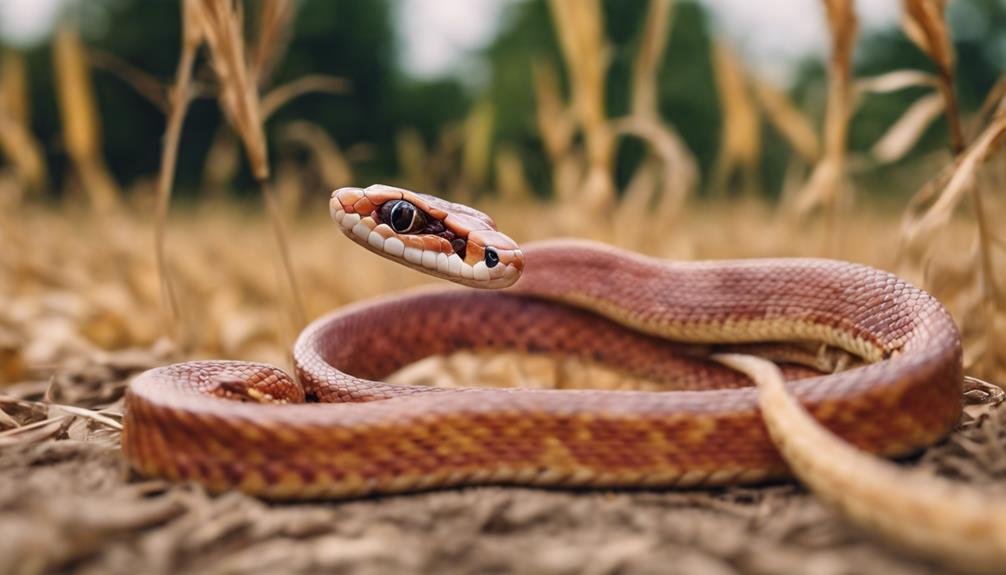You might wonder if corn snakes are venomous and whether you should be wary around them. These mesmerizing reptiles are indeed non-venomous, relying on constriction to subdue their prey rather than venom. Their reputation for being docile makes them a favorite among pet enthusiasts, but does that mean they pose no threat at all? While their bites are generally harmless to humans, understanding the nuances of their behavior and how to interact with them safely is essential. Let's explore the truth behind their gentle nature and uncover some practices that guarantee a harmonious relationship with these misunderstood creatures.
Key Takeaways
- Corn snakes are non-venomous, posing no threat to humans with their bites.
- They use constriction, not venom, to subdue their prey, making them safe to handle.
- Their docile nature and reluctance to bite make them popular pets among reptile enthusiasts.
- Proper handling and understanding of corn snake behavior significantly reduce the risk of bites.
- Recognizing their beneficial role in controlling pest populations highlights their importance rather than a cause for concern.
Understanding Corn Snakes
Corn snakes, with their non-venomous nature and colorful appearance, play an essential role in maintaining the balance of our ecosystem. You might be wary when you cross paths with one, given their resemblance to the more dangerous copperheads. However, understanding their behavior and the myths surrounding their venom can help alleviate any fears.
Firstly, it's key to know that corn snakes aren't out to harm you. Their diet mainly consists of pests, which they control, thereby benefiting your garden and home. They're often mistaken for venomous snakes due to their colorful patterns, which closely mimic Indian corn, hence their name. This resemblance is a survival tactic, not a sign of danger.
The myths about corn snakes being venomous are just that – myths. These creatures are fundamentally different from their venomous cousins. They lack the ability to produce venom and instead use constriction to subdue their prey. Understanding this can shift the way you see these snakes, from a potential threat to an environmental ally. Give them space to coexist peacefully, and they'll continue to play their pivotal role in our ecosystem without posing any risk to you.
The Nature of Venom
Understanding that corn snakes are non-venomous, it's also important for you to know what venom actually is and why its absence in these snakes matters. Venom is basically a toxic substance produced by some animals, including certain snake species, used primarily for immobilizing prey and for defense. However, corn snakes, lacking venom, rely on a different method—constriction—to subdue their prey.
Here are four key points to deepen your understanding of snake venom and why not having it makes corn snakes a safer option for pet enthusiasts:
- Venomous vs Non-Venomous: Venomous snakes have specialized glands for producing venom, which corn snakes lack.
- Prey Capture Method: Corn snakes use constriction, not venom, to subdue their prey, highlighting a significant difference in hunting techniques.
- Safety for Humans: Their non-venomous nature significantly reduces any threat to humans, debunking misconceptions about their danger.
- Handling Ease: Without venom, corn snakes are considered safer to handle, making them popular pets among reptile enthusiasts.
Understanding snake venom and recognizing the non-venomous nature of corn snakes helps debunk misconceptions and highlights why they're an appealing choice for those interested in reptiles.
Corn Snakes: Harmful or Harmless?
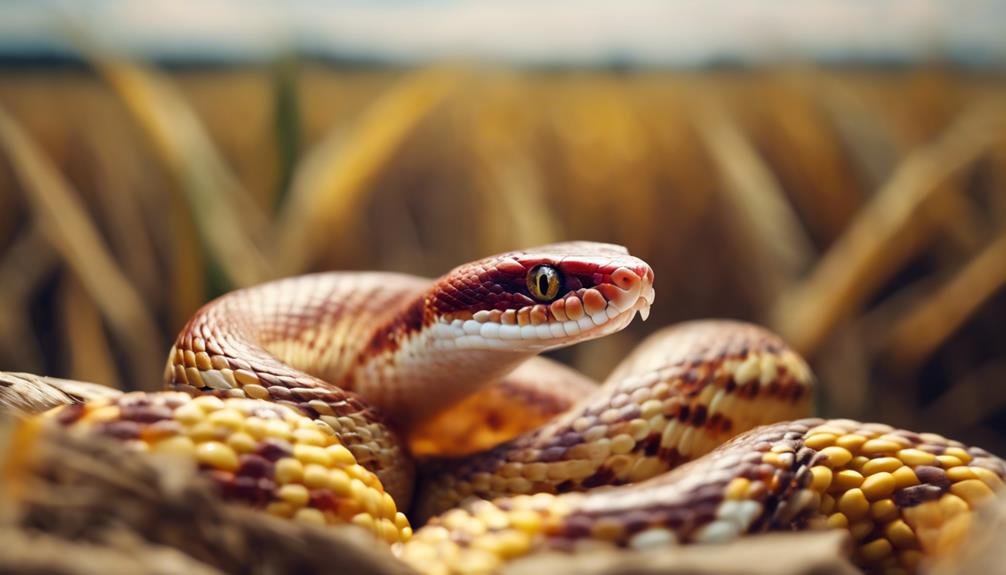

You might wonder if corn snakes can pose any danger to you or your family.
We're going to explore the facts about their venom, understand the risks involved with their bite, and share safe handling practices.
This will help you see that corn snakes are generally harmless and can safely coexist with humans.
Corn Snake Venom Facts
Despite their intimidating appearance, corn snakes aren't venomous and pose no danger to humans. Their lack of venom and gentle nature dispel venomous misconceptions, making them favored pets, especially among beginner reptile enthusiasts. Understanding snake handling techniques guarantees a safe and enjoyable experience for both you and your corn snake.
To deepen your understanding, consider these facts:
- Corn snakes use constriction, not venom, to subdue their prey.
- They're known for their docile nature, rarely showing aggression towards humans.
- Their vibrant colors and manageable size appeal to reptile lovers.
- No cases of corn snake venom affecting humans exist, reinforcing their status as harmless pets.
Bite Risks Explained
While corn snakes are known for their non-venomous nature, it's still important to consider the rare instances when they might bite. Understanding snake behavior is key to minimizing these rare occurrences. Corn snakes don't possess venom glands, so they pose no threat to humans. A bite from them is typically harmless, causing about as much pain as a pinprick, with no serious effects.
These reptiles rarely bite unless provoked or feel threatened, preferring to flee or hide. Their docile nature makes them popular among reptile enthusiasts and beginners alike. Proper reptile care, including respectful handling and giving them space, is essential. It promotes positive interactions and prevents bites, highlighting their status as harmless and manageable pets.
Safe Handling Practices
To guarantee your corn snake remains stress-free and healthy, mastering safe handling practices is crucial. These creatures are non-venomous and naturally docile, making them fantastic companions, especially for beginners. However, guaranteeing their well-being requires understanding and respecting their needs, particularly when it comes to handling and stress management.
Here are four key points for safe interaction:
- Handling Precautions: Always support their body gently to prevent stress.
- Stress Management: Avoid sudden movements to keep them calm.
- Shedding Concerns: Refrain from handling during shedding; they may be more irritable.
- Hygiene: Wash your hands before and after to prevent the spread of bacteria.
Adhering to these guidelines ensures a harmonious relationship with your corn snake, making your experience both safe and enjoyable.
Identifying a Corn Snake
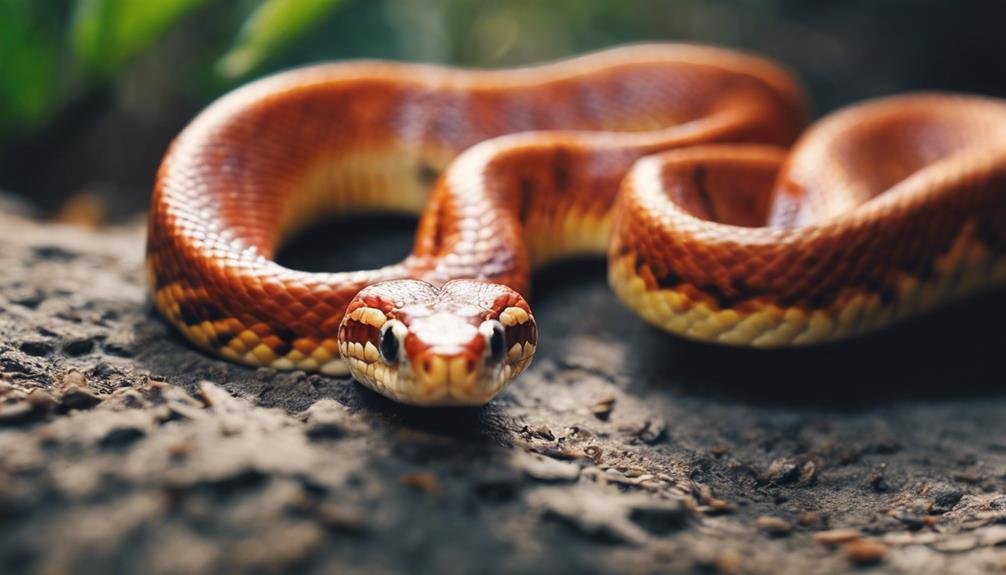

You're about to learn how to spot a corn snake by exploring their common physical characteristics, where they live, and how they behave.
Recognizing these snakes involves noting their unique color patterns and slender body shape.
Understanding their habitat, distribution, and temperament will also help you identify them correctly and appreciate their role in nature.
Common Physical Characteristics
Identifying a corn snake is straightforward due to its distinctive physical characteristics, such as the colorful dorsal side and unique checkerboard pattern on its belly. These snakes are fascinating creatures, and knowing how to identify them can enhance your understanding and appreciation of their role in nature.
- Colorful patterns: Corn snakes display a range of colors on their dorsal side, including orange, reddish, gray, or brownish hues, adorned with large reddish-brown blotches.
- Slender body: Their body shape is relatively slender, resembling a loaf of bread, making them quite distinctive.
- Checkerboard belly: The belly showcases a distinctive black-and-white checkerboard pattern, a key identifier.
- Keel scales: While their scales are glossy, they've weak keels, adding texture to their appearance.
Habitat and Distribution
Corn snakes primarily inhabit the southeastern United States, thriving in environments ranging from lush forests to abandoned buildings. You'll find them in states like Florida, Georgia, and the Carolinas, showcasing their distinctive orange, reddish, or brownish coloration and unique black-and-white checkerboard pattern on their bellies. This coloration not only helps in identifying them but also in understanding their natural habitat and distribution patterns.
As you explore their habitats, ranging from forests to grasslands, it's essential to note the impact of habitat destruction on their population trends. Conservation efforts are key in maintaining their numbers and ensuring these non-venomous creatures continue to play their role in the ecosystem. Recognizing their distribution and the importance of preserving their habitats helps in distinguishing them from other snake species and underscores the importance of environmental conservation.
Behavior and Temperament
While corn snakes are known for their non-venomous nature, it's their calm temperament that truly sets them apart, making them ideal pets for those new to snake ownership. Their docile behavior and reluctance to bite unless mishandled make them excellent for beginners.
However, understanding their behavioral cues and proper handling tips can enhance your experience and guarantee the well-being of your pet.
- Always support their body fully when handling to prevent stress.
- Learn to recognize when your corn snake is feeling threatened, such as tail vibrating.
- Handle your snake regularly, but not excessively, to maintain their calm nature.
- Avoid handling after feeding to prevent regurgitation and stress.
The Diet of Corn Snakes
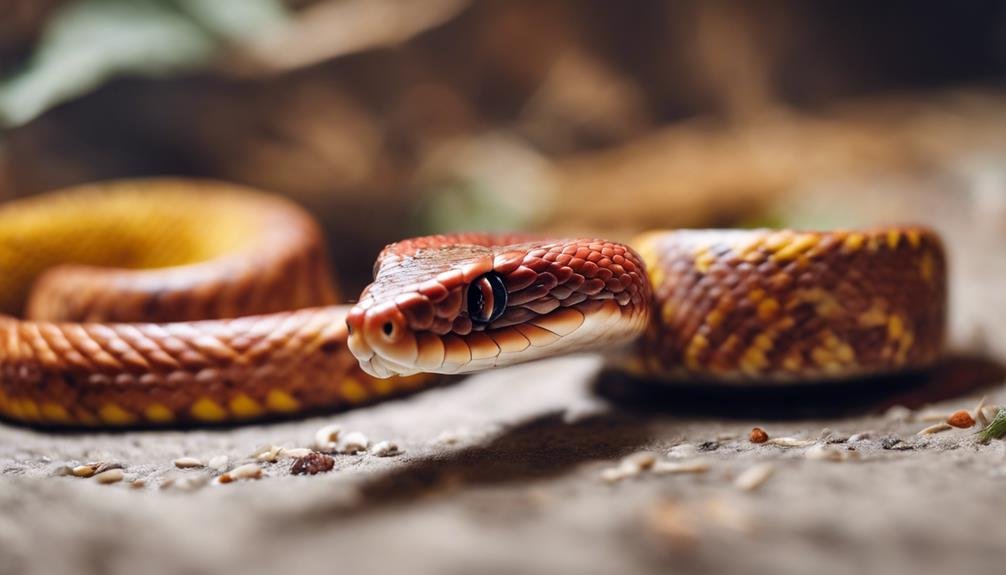

Understanding the diet of corn snakes is essential for appreciating how they contribute to controlling pest populations. These reptiles primarily feast on rodents, small mammals, birds, and their eggs. It's fascinating to note that juvenile corn snakes often have a different menu, including lizards and frogs, until they grow bigger. This variation in prey highlights their adaptability and the significant role they play in maintaining the balance within their habitats.
Diving into their feeding habits, corn snakes are non-venomous and employ constriction as their method to subdue prey. This means they wrap their bodies around their catch, squeezing until it suffocates, demonstrating a natural and effective way to control rodent populations without the use of poisons or traps. Their prey preferences further underline their importance in pest management, as they naturally target species that can often become nuisances in homes and farms.
Corn Snakes in the Ecosystem
In their natural habitats, corn snakes greatly contribute to ecological balance by managing pest populations. These serpents are an essential part of the ecosystem, ensuring a healthy environment by keeping rodent numbers in check. Their role extends beyond mere pest control; they're a key component in maintaining ecosystem balance and promoting human safety. By naturally controlling pests, they minimize the need for chemical pest control methods, which can have harmful ecological effects.
Here's how corn snakes support the ecosystem and human well-being:
- Ecosystem balance: They regulate the populations of small mammals and birds, preventing overpopulation and the resultant environmental degradation.
- Pest control: By feeding on pests, corn snakes help protect crops and property, indirectly supporting agriculture and reducing economic losses.
- Human safety: Their non-venomous nature and role in controlling pests that might spread diseases to humans highlight their ecological benefits.
- Support for predators: Acting as prey for larger animals, they're integral in the food chain, supporting biodiversity.
Understanding and respecting the ecological importance of corn snakes can lead to peaceful coexistence, where both humans and snakes benefit from each other's presence.
Handling and Safety Tips
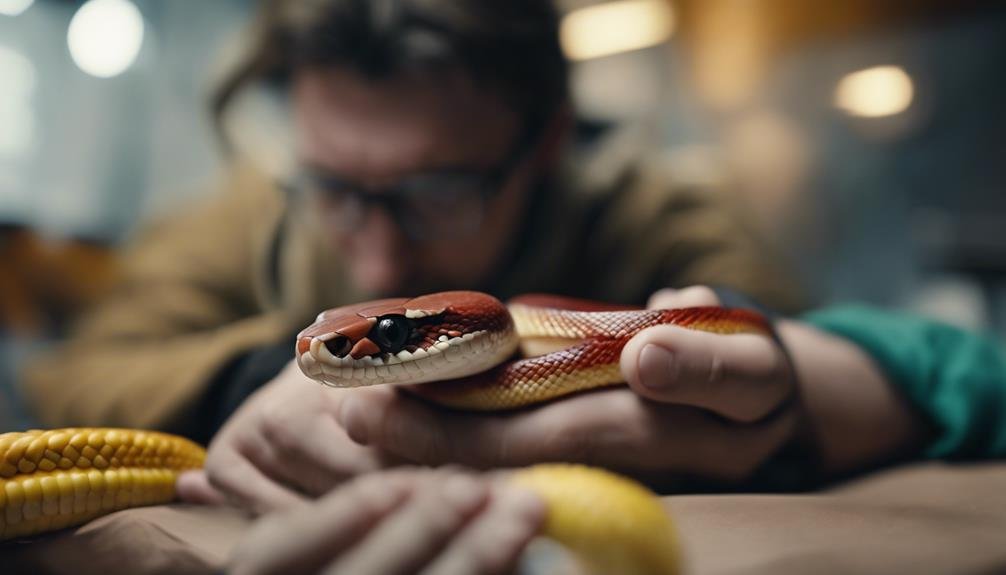

To guarantee a safe experience, it's vital to handle corn snakes with care and be mindful of their comfort. Being gentle and avoiding sudden movements are key to preventing injury and ensuring your corn snake doesn't feel threatened. Remember, these creatures rely on their perception of their environment to feel secure.
| Safety Tip | Importance | Outcome |
|---|---|---|
| Gentle Handling | Prevents the snake from feeling threatened | Reduces stress for the snake |
| Wash Hands After Handling | Prevents salmonella transmission | Protects your health |
| Proper Support | Ensures safety for both snake and handler | Prevents injury |
Always wash your hands thoroughly after handling your corn snake. This is a vital health precaution to avoid potential risks like salmonella, which can be transmitted from reptiles to humans. If you're feeling unwell or have open wounds, it's best to avoid handling your snake to reduce the risk of infection. In the rare case you're bitten, clean the wound thoroughly. Although corn snake bites aren't venomous, seeking medical attention if necessary is a prudent step. By following these guidelines, you'll maintain both your and your snake's well-being.
Common Myths Debunked
Dispelling myths about corn snakes reveals they're actually non-venomous and beneficial to our ecosystem. Despite common fears, these colorful reptiles are more friend than foe. Let's debunk some widespread snake misconceptions and shed light on corn snake benefits and the ecosystem importance.
- Corn snakes are venomous: This is one of the biggest venom myths out there. Corn snakes don't have venom glands and pose no venomous threat to humans.
- Corn snakes are aggressive: In reality, corn snakes are quite docile and unlikely to bite unless they feel threatened. Understanding their behavior can help minimize fear.
- All snakes are pests: Far from being nuisances, corn snakes play a significant role in controlling pest populations, showcasing their ecosystem importance. They help maintain a balanced environment by preying on rodents that could otherwise become problematic.
- Corn snakes are easily mistaken for venomous snakes: Although they might resemble some venomous species, their checkerboard-patterned belly is a key identifier, helping to distinguish them from their venomous counterparts.
Recognizing these facts can help alleviate concerns and foster a greater appreciation for the role corn snakes play in our natural world.
Should I Be Concerned or Afraid of Corn Snakes if I Encounter Them?
When encountering corn snakes, safety concerns may arise, but there is no need to be afraid. Corn snakes are non-venomous and pose little threat to humans. It’s important to approach them with caution and respect, but there is no need for concern as long as proper safety measures are taken.
Coexisting With Corn Snakes
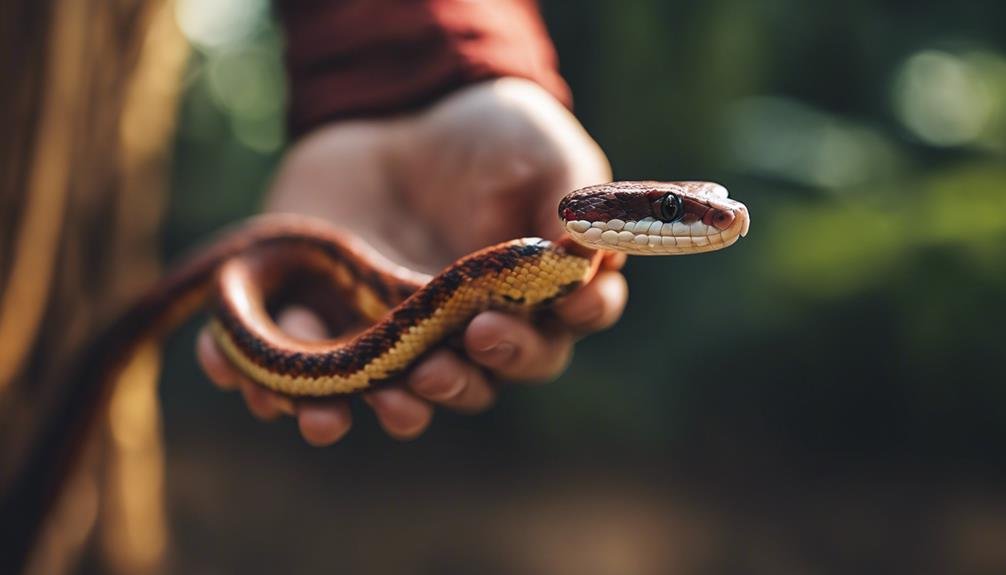

Why not learn how to live harmoniously with corn snakes, considering they're shy and pose minimal threat when undisturbed? Understanding snake behavior is important in fostering positive wildlife interactions, especially with species like corn snakes that are often misunderstood. These creatures are an essential part of the environment, contributing greatly to the ecosystem by controlling pest populations. Rather than fearing them, it's best to give corn snakes space and time to move away if you encounter them. This approach not only respects their natural behavior but also minimizes any potential stress on the snake.
Learning about corn snakes can dramatically change how you view them, transforming concern into coexistence. By recognizing their beneficial role and knowing they're not inclined to bite unless provoked, you can feel more at ease when you spot one in your surroundings. Remember, understanding their behavior and characteristics alleviates unnecessary fears, paving the way for a peaceful cohabitation. So next time you cross paths with a corn snake, consider it an opportunity to practice patience and appreciation for these fascinating creatures and their place in our world's intricate web of wildlife interactions.
Conclusion
To conclude, you have nothing to worry about with corn snakes. They're not venomous and are actually quite gentle creatures, making them perfect pets for reptile lovers.
Just remember to handle them properly to avoid any rare bites, which are harmless anyway.
By debunking common myths and understanding their role in the ecosystem, you can appreciate these colorful snakes even more.
So, coexist peacefully with corn snakes and enjoy the unique companionship they offer.

